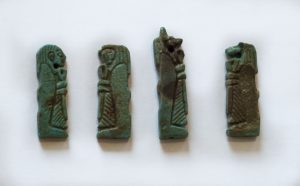Four Sons of Horus
 Four Sons of Horus
Four Sons of Horus
The Four Sons of Horus protected the innards of the deceased. In the Pyramid Texts, they help the king ascend to heaven. By the New Kingdom, the four are associated with protecting the body of Osiris and with the constellation of the the Great Bear.
The Four Sons of Horus, who are commonly known as the deities of the four canopic jars which held the viscera of the deceased. These were known variously as the Children of Atum, the Children of Geb, the Children of Nut, the Nobles of the Gods, the Four Adolescents and the Children of Horus. Horus of Khem, Harsiese and Horus the Elder (sky gods) are cited in different texts as being their father. As sons of Horus of Khem, the Four were linked with Khem (Letopolis), a place of storms, flint and meteoric iron. Both meteoric iron and flint were mythologically linked with the northern sky, and with the Four Sons, who were named Imsety, Hapy, Duamutef and Kebehsenuef.
Their importance centered on their place in the northern sky and particularly in the Egyptian constellation Meskhetyu (transliteration, Msxtwy); their status as primeval gods; and their link with the cardinal points. They first emerge in the Pyramid Texts as helpers of the deceased king.
The Four were usually portrayed as mummiform; the wrapped body often symbolised ancestors, including primeval gods. From the Eighteenth Dynasty (1550–1295 bc) the Four were often coupled with the lotus (waterlily), a symbol of primeval birth, and are shown standing on it. According to one version of the Heliopolitan creation myth, the lotus flower gave rise to the first solar god. Four other primeval male creator gods, who may be loosely related to the Four Sons, featured heavily in the Coffin Texts.
The Four Sons not only protected Osiris but ensured the safety of the sun-god Re as he travelled across the night sky. In the tenth division of the Book of Gates, the Four restrain the snakes who help Apep, the arch-enemy of Re.
The Four Sons of Horus were associated with the canopic jars within which the viscera was placed as part of mummification. Generally, Imsety, Hapy, Duamutef and Kebehsenuef were linked with the liver, lungs, stomach and intestines respectively, though sometimes the associations of Hapy and Duamutef are found switched about and at other times there is very little correspondence between canopic jar contents and the traditionally associated deity. This is possibly because it was the conceptions surrounding the number four, a number of completeness, together with the vigil, which were important, rather than any link between a particular body part and a specific Son. Furthermore, while ideally placement of the internal organs in the body corresponded with the position of the Sons of Horus, the embalming process was messy and intended connections could have been lost.
From the Twentieth Dynasty until the Roman Period (c.1100–30 bc) each of the four canopic jars had a particular head: Imsety (human-headed), Hapy (head of a baboon), Duamutef (head of a dog) and Qebehsenuef (head of a falcon). The Egypt Centre has one seeming seemingly complete jar, with the head of Imsety but all is not as it seems.
Further Reading:
Graves-Brown, C. 2018. Daemons and Spirits. University of Wales Press.
Taylor, J.H. 2001. Death and the Afterlife in Ancient Egypt, London, 67-68.